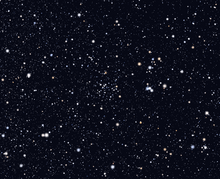NGC 6811
| NGC 6811 | |
|---|---|
 | |
| Observation data (2000.0 epoch) | |
| Right ascension | 19h 37m 17s[1] |
| Declination | +46° 23′ 18″ |
| Distance | 3600 ly[2] (1107 pc[2]) |
| Apparent magnitude (V) | 6.8 |
| Apparent dimensions (V) | 13' |
| Physical characteristics | |
| Associations | |
| Constellation | Cygnus |
NGC 6811 is an open cluster in the constellation of Cygnus,[3] near the constellation of Lyra.[4] It has an angular size half that of the full Moon and includes about 1000 stars[5] of roughly similar magnitude.[3][6] It has also been called "The Hole in the Cluster" because of its dark center.[6][7]
Features
NGC 6811 lies far away from the galactic plane, a feature it shares with many other old open clusters.[6] It is 1107 ± 90 parsecs distant,[2][8] 14–20 light years across,[6][9] and has a total luminosity of 2100 suns.[9] Approximately 1.00 ± 0.17 billion years old, it probably contained some 6000 stars at birth,[5] but gravitational interactions and stellar evolution have since reduced the number to 1000.[5] The spectral types of most of its stars range from mid-F to early-K, with surface temperatures relatively similar to the Sun's;[4] the rest include A2-types,[9] several O-types, and more than 100 B-types.[5] Sixteen stars have been observed to vary in brightness, twelve of which are Delta Scuti variables.[10] Its Trumpler classification is III 1r—it is "a rich cluster with equally bright stars with no noticeable central concentration".[6] The stars do, however, have an unusual (if not concentrated) distribution, with an apparent corona surrounding the core, leaving the impression of a hole.[6]
Observation
NGC 6811 was first observed by John Herschel in 1829 and was added to his General Catalogue of Nebulae and Clusters in 1864.[11] The cluster has recently been the subject of study by the Kepler mission, with the aim of characterizing its stars' rotation rate, age, and distance to help the hunt for exoplanets.[4]
NGC 6811 is best observed from Earth in the Northern Hemisphere in summer. In these conditions it lies close to the zenith during the night, northeast of Delta Cygni.[3] It is considered an aesthetically pleasant object for amateur astronomers, even if the brightest members are just 10th magnitude objects. It appears as a hazy patch in 10x binoculars, but it is best seen at around 70x with a moderate-aperture telescope.[9] It has been described by amateur astronomers as a "smoke ring of stars" or "a jeweled mask a woman might wear at a masquerade ball".[6]
Planets
Two planets (Kepler 66b and Kepler 67b), orbiting Sun-like stars in the NGC 6811 cluster, have been discovered by the Kepler mission using the transit method.[2] Both planets are smaller than Neptune and are both the first sub-Jupiter planets and the first transiting planets discovered orbiting stars within an open cluster.[2] Given that the age and distance of the cluster have been accurately measured, the two planets are among the few of which age and distance are accurately known.[12] This finding suggests that the frequency of planets in clusters is similar to that in stars not belonging to clusters or associations[2][12] and that planets can form and survive in environments more crowded and violent than the one of our own Sun.[5]

See also
References
- ^ "SIMBAD Astronomical Database". Results for NGC 6811. Retrieved 11 May 2013.
- ^ a b c d e f Meibom, S. R.; Torres, G.; Fressin, F.; Latham, D. W.; Rowe, J. F.; Ciardi, D. R.; Bryson, S. T.; Rogers, L. A.; Henze, C. E.; Janes, K.; Barnes, S. A.; Marcy, G. W.; Isaacson, H.; Fischer, D. A.; Howell, S. B.; Horch, E. P.; Jenkins, J. M.; Schuler, S. C.; Crepp, J. (2013). "The same frequency of planets inside and outside open clusters of stars". Nature. 499 (7456): 55–58. arXiv:1307.5842. Bibcode:2013Natur.499...55M. doi:10.1038/nature12279. PMID 23803764.
- ^ a b c Anthony Ayiomamitis. "NGC 6811". Astronomy Magazine. Kalmach Publishing Co. Retrieved 9 July 2013.
- ^ a b c Meibom, S. R.; Barnes, S. A.; Latham, D. W.; Batalha, N.; Borucki, W. J.; Koch, D. G.; Basri, G.; Walkowicz, L. M.; Janes, K. A.; Jenkins, J.; Van Cleve, J.; Haas, M. R.; Bryson, S. T.; Dupree, A. K.; Furesz, G.; Szentgyorgyi, A. H.; Buchhave, L. A.; Clarke, B. D.; Twicken, J. D.; Quintana, E. V. (2011). "The Kepler Cluster Study: Stellar Rotation in Ngc 6811". The Astrophysical Journal. 733: L9. arXiv:1104.2912. Bibcode:2011ApJ...733L...9M. doi:10.1088/2041-8205/733/1/L9.
- ^ a b c d e Shari Balouchi. "Crowded Clusters Can Host Planets, Too". Sky and Telescope. Retrieved 9 July 2013.
- ^ a b c d e f g Stephen James O'Meara (30 June 2011). Deep-Sky Companions: The Secret Deep. Cambridge University Press. pp. 389–. ISBN 978-1-139-50007-4. Retrieved 9 July 2013.
- ^ L. Phil Simpson (2012). Guidebook to the Constellations. Springer. pp. 505–. ISBN 978-1-4419-6941-5. Retrieved 9 July 2013.
- ^ Janes, K.; Barnes, S. A.; Meibom, S. R.; Hoq, S. (2013). "Ngc 6811: An Intermediate-Age Cluster in the Kepler Field". The Astronomical Journal. 145: 7. Bibcode:2013AJ....145....7J. doi:10.1088/0004-6256/145/1/7.
- ^ a b c d Craig Crossen; Gerald Rhemann (27 January 2004). Sky Vistas: Astronomy for Binoculars and Richest-Field Telescopes. Springer. pp. 67–. ISBN 978-3-211-00851-5. Retrieved 9 July 2013.
- ^ Luo, Y. P.; Zhang, X. B.; Luo, C. Q.; Deng, L. C.; Luo, Z. Q. (2009). "Variable stars in the open cluster NGC 6811". New Astronomy. 14 (6): 584. Bibcode:2009NewA...14..584L. doi:10.1016/j.newast.2009.02.005.
- ^ "The NGC/IC Project". Results for NGC 6811. Retrieved 11 May 2013.
- ^ a b "First Transiting Planets in a Star Cluster Discovered". Harvard-Smithsonian Center for Astrophysics. Retrieved 9 July 2013.
